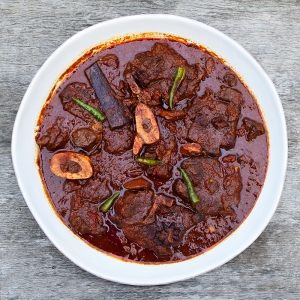
I improvised this beef curry back in December. I’d thawed a pack of what had been labeled soup bones by the meat locker through which we’d bought a quarter of a cow a while ago. The plan had been to make pho. But when I opened the packet they turned out instead to be highly meaty shanks. I pivoted to making a slow-cooked curry and decided to take this opportunity to also finally use up an open bottle of red wine that had been sitting in the fridge for god knows how long. Meat, spices, a long braise on low heat: what could go wrong. Absolutely nothing, you’re thinking, and you’re absolutely right. Nothing did go wrong. In fact, things went very, very right. And here is the recipe to prove it. Please keep in mind that even though the recipe makes it look like a fixed thing this was—as with almost all my cooking—made on the fly. Feel free to play with the proportions of spice and ratios of tomato, red wine and water. There happened to be roughly two cups of wine left in the bottle but I would have added whatever had been in there. Who’s to say it wouldn’t have been ever better if braised entirely in wine? If you do tinker let me know how it goes.
Ingredients
- 3-4 lbs of beef shanks (or chuck roast or similar cut into large chunks)
- The following whole garam masala: a large piece cinnamon/cassia bark, 5 pods green cardamom, 5-7 cloves, 3 star anise
- A large red onion, halved and thickly sliced
- 1 tspn freshly pounded garlic
- 1 tspn freshly pounded ginger
- The following ground to a coarse powder: 1 tspn coriander seed, 1 tspn cumin seed, 1 tspn black peppercorn, 1/2 tspn methifenugreek seeds, 2 hot dried red chillies, 3 Byadgi or Kashmiri chillies [affiliate links]
- 3/4 tspn haldi/turmeric powder
- 2 cups diced tomato with juice
- 2 cups red wine
- Hot water off the boil
- 1 tblspn jaggery or dark brown sugar (optional)
- 3-5 slit Thai chillies (optional)
- Salt
- Neutral oil of choice
- 2 tblspns chopped dhania/cilantro
Preparation
- Lightly salt the meat on both sides.
- Heat a cast-iron pan over medium heat. When hot add a tablespoon or two of oil and brown the meat on both sides. Keep aside.
- In a Dutch oven (enameled cast iron is best) heat 2-3 tablespoons of oil over medium heat and when it shimmers add the whole garam masala.
- As soon as the garam masala becomes fragrant (very soon), add the sliced onions. Saute till softened and beginning to brown around the edges.
- Add the pounded garlic and ginger and saute till the raw aroma is gone.
- Add the powdered spices and haldi, mix in and saute, stirring constantly for another 2-3 minutes.
- Add the tomatoes and salt, mix in thoroughly and saute, stirring often, till the tomatoes have completely cooked down and the oil separates.
- Add the browned meat to the pan and turn a few times.
- Add the wine to the pan and add enough water right off the boil to cover the meat.
- Cover, reduce the heat to low and cook at a simmer till the meat is just fork tender.
- Uncover, add the jaggery and slit green chillies if using and simmer uncovered for another 15-30 minutes or till the curry is thickened but still very pourable.
- Taste and adjust salt as needed, garnish with dhania and serve with parathas or steamed rice.
Notes
- If you don’t have shanks use whatever roast or stew meat you have. It’s nice to have some bones in there for extra flavour and texture though; and it’s even nicer if the bones have some marrow.
- I left the shanks whole through the cooking process—as you can see if you follow the link up top to the Twitter thread I’d posted while cooking this. The meat came off the bone as it cooked and I broke it up further into smaller chunks with a spatula when tender. If using a roast or brisket you could either cut it up before browning or leave it whole through the whole process and then remove it at the end and gently slice it.
- For a more robustly spiced version you could double the amount of coriander seed, cumin and methi in the ground spices. I wouldn’t make it very much hotter though. If you use the slit Thai chillies at the end they will add a bright heat as well.
- The optional jaggery/brown sugar is there in case your wine is very acidic.
- This is very good with steamed rice but is even better with parathas or chapatis. And like all meat curries it will be even better on day 2 and day 3.

